Dominant, Minor And Major Seventh Chords on Guitar
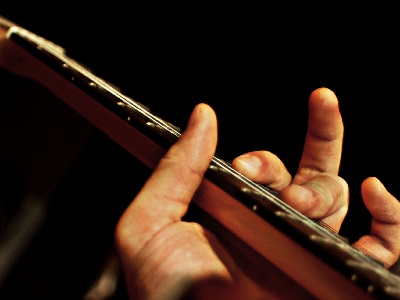 Besides the basic minor and major chords, the next most common chord type a guitarist would come across would be (7th) seventh chords. Basically, seventh chords are comprised of 4 notes and are similarly structured to the major and minor chords.
Besides the basic minor and major chords, the next most common chord type a guitarist would come across would be (7th) seventh chords. Basically, seventh chords are comprised of 4 notes and are similarly structured to the major and minor chords.
Perhaps the toughest part in learning seventh chords lies in the fact that there are currently no standardized methods in writing them. In my personal experience, I had come across different forms in which the chords are written in tabs, song books and chord dictionaries.
Since this is the main cause of confusion that’s causing problems with the seventh chords (e.g. dominant seventh). I hope to address this issue once and for all.
Major Seventh Chord
First, let’s understand how the major seventh chords are built. Using the C major scale as an example, I had listed the following notes and their intervals in the table below…

The C major seventh chord (Cmaj7) is comprised of a C major chord (root, third & fifth) + the 7th note of the major scale. From the table above, you can derive that the Cmaj7 chord comprises of the notes: C-E-G-B.
As I mentioned earlier, the major seventh chords can be represented in writing using many different standards. If you come across any of the following notations: M7, Maj7th, 7M or ⌂7, they all represent the same thing – a major 7th chord.
Minor Seventh Chord
Like the major seventh chord, the minor seventh chord can also be derived from the major scale. The chord consists of the (root, flatted third & fifth) + flatted 7th note. The difference from the major seventh chord is that there are 2 flatted notes in the formula instead.
Using the table above, you can see that the Cmin7 chord comprises of the notes: C-Eb-G-Bb. In written form, the minor 7th chord can be listed as m7, min7th, 7m or -7.
Commonly Found Major 7th & Minor 7th Chords In Music
Now that we had covered the theoretical part of the lesson, let’s give your fingers a little workout by learning some of the most commonly used seventh chords and their applications.
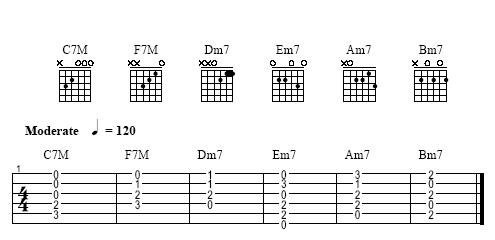
Try strumming these chords one after the other and listen to how they sound like. Unlike the diminished or augmented chords, the 7th chords don’t feel dissonant and can be used as standalone chords.
Typically, 7th chords are the main staples of playing jazz music. However, aside from jazz styled genres, many guitarists also add in an occasional major or minor 7th chord to spice up chord progressions in rock, country and folk tunes.
Autumn Leaves – A Great Practice Song For 7th Chords
To get a better feel of how the major and minor 7th chords sound like in a real-life song, listen to this jazz example.
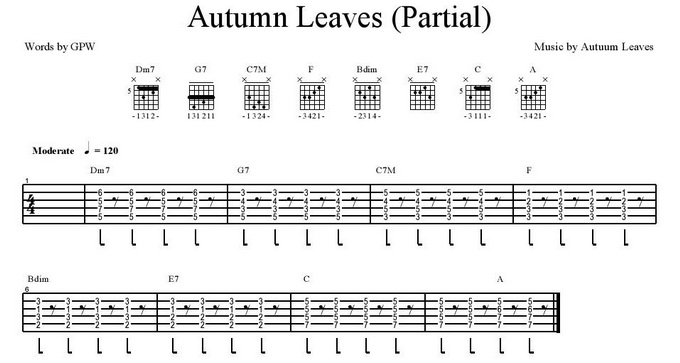
Download .gtp5 or .mp3 file ( Right-click Save Target as… )
Dominant Seventh Chords
By default, when you hear guitar players refer to seventh chords, they are referring to the dominant 7ths unless specified otherwise. These chords cause dissonance in songs and are often used for leading to the root, or I chord. As a result, dominant seventh chords are also frequently used to facilitate key changes during a song.
Note that a dominant seventh chord is not the same as a major seventh chord. Using the C key as an example again, the C dominant seventh chord is formed by a C major chord (root, third & fifth) + the flatted 7th note of the major scale. The C dominant seventh chord comprises of the following notes: C-E-G-Bb.
Alternatively, it can also be formed by simply lowering the 7th note of a major seventh chord by a semitone. The most common ways of listing dominant 7th chords is C7.
Tritone – What Makes The Dominant 7th Special Sounding
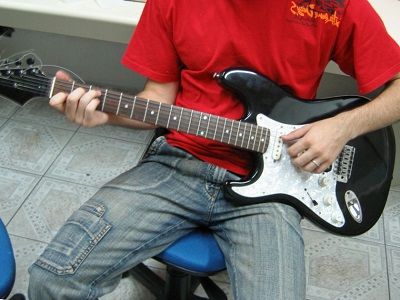
The tone that makes the dominant seventh so important, is the tritone, which is a diminished fifth, or augmented fourth, formed between the third and seventh of the chord. The tone and the two notes “define” the scale that is being used.
For example, in the key of A Major, the dominant seventh chord is E7. The notes in E7 are E G# B D. The distance between the 3rd and the 7th of this chord, is a tritone, or diminished 5th. In no other major scale will you find both G# and D.
Practicing Your Dominant 7ths
To practice finding and forming dominant sevenths on the guitar fretboard, you need to first picture where the major triads are located. Finding the seventh note is easy enough, then simply lower the seventh by one fret, and you have the necessary notes to form the dominant seventh chord boxes.
The voicing of the dominant seventh guitar chord should be easy for your fingers to fret properly. Once you have the individual notes figured out, don’t restrict yourself to forming the chords with the root as the lowest note. The fingering is just too impractical in most cases.
Try to barre as many notes as you can, and become comfortable with two easy voicings per seventh chord you learn. This allows you to make quick, clean transitions to the dominant seventh chords when you are playing.
Before we end this lesson, here’s a song for you to try out. “Hey Jude!” is one of the most famous songs by the Beatles that uses the dominant 7th chords and is a great example to learn.
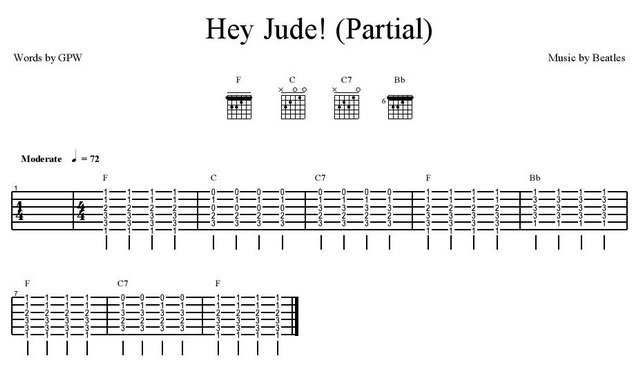
Download .gtp5 or .mp3 file ( Right-click Save Target as… )







Leave A Comment